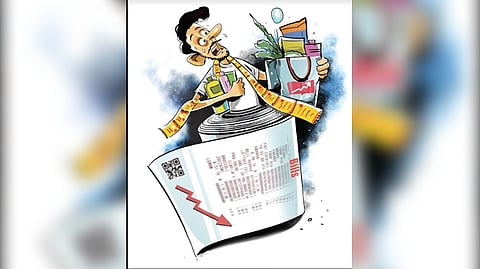

CHENNAI: If you’ve been paying more for essential items at the neighbouring stores in recent days, chances are that you’ve been hit by inflation.
Increase in prices has burned the monthly budget of the common man, especially those living in the lower middle and middle classes, who’ve reduced the number of grocery items they buy each month.
However, market insiders stated that though there was a steady flow of supply of commodities, the demand had also gone up.
“The price of essential items drastically surged in the last few years. We struggled to run the family after the pandemic-induced lockdown, as the prices of essential commodities increased. Earlier, we spent at least Rs 5,000 per month to purchase essential things for home, whereas now, we spend Rs 10,000-15,000. Otherwise, we’re unable to get quality products,” said A Swathi, who works at a textile store in Purasawalkam.
It’s a similar case with people below poverty line as well. P Kanniyappan, a daily wager’s weekly salary is Rs 1,000-Rs 1,500. Usually, he buys vegetables and required groceries every day, but the rates surged recently. Kanniyappan was forced to reduce the quantity of commodities and cut down his daily tea expenses.
To reduce the burden of expenses, people have been buying from ration shops in the city. S Sivaraman, an IT employee stated, “The cost of buying groceries has increased by 10% post lockdown. It may seem like a small amount, but we’re unable to manage other expenses like housing loans and educational fees. Recently, we started buying sugar, wheat and oil from the ration shop.”
Due to the conflict between Russia and Ukraine, prices of sunflower, and palm oil surged in the city in March 2022, as 90% of cooking oil was imported from these two countries. Prices decreased a bit around November 2022.
T Chandrasekharan, general secretary, TN Oil, and Seeds Association in George Town, said that price of oil has gradually decreased compared to last year. Currently, 15 litres of sunflower oil costs Rs 2,270 – Rs 2,345, 10 kg of palm oil is Rs 955, and 15 litres of groundnut oil costs Rs 2,885. This is still expensive for the middle class, and so it affects sales.
“Compared to essential items like dhal, wheat, maida, spices and rice, prices of cosmetic products including soap, shampoo have been quite lofty in the past one year. However, customers don’t scrimp on these but they do limit their purchase of essential commodities,” said R Punniappan, a wholesale trader in the city.
Similarly, vegetable prices remained low for at least a year due to steady flow of supply from Tamil Nadu, Andhra Pradesh, and Karnataka. But it slightly increased from last week due to brisk sales, and shortage in supply. Traders at Koyambedu wholesale market claim that the inflation is below 10% at present, and only when it crosses 15% it’d become a serious concern.
“Based on cultivation, vegetable prices differ. Inflation was high in 2010–2011; it was above 15%. The State experienced monsoon failure, and even the government did not do much to improvise the agricultural sector. Also, during the pandemic-induced lockdown in 2020, vegetable prices surged abnormally as there was severe shortage in supply due to lack of transportation,” stated P Sukumaran, secretary, Koyambedu Wholesale Market Merchants Association. “The State government has to improvise storage facilities for perishable commodities. It’s one of the ways that’d help farmers manage inflation for the next five years.”
Commenting on how inflation impacts the common people, Va Nagappan, an economic observer noted that in the previous year, if the rates did not increase substantially, even a small surge will hit hard. “People below the poverty line are not affected much because things have been taken care of by the government. For instance, free travel for women in MTC buses. Most are given subsidiary food of 15 kg. Medical expenses are also taken care of,” he explained.
But inflation hits middle and lower-middle class hardest as they don’t enjoy major government subsidies. “One of the major reasons for surge in inflation is though there is adequate supply, the demand for every product has increased in recent years. They keep spending a lot of money on unnecessary expenses, and people justify it,” expressed Nagappan.
Visit news.dtnext.in to explore our interactive epaper!
Download the DT Next app for more exciting features!
Click here for iOS
Click here for Android